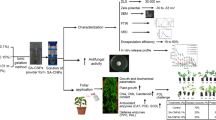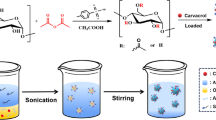Abstract
Nanotechnology can change the scenario of current tools minimizing the chemical inputs in plant protection. Here, novel poly(dl-lactide-co-glycolide acid) (PLGA) copolymer-based biopolymeric nanoparticles (NP) and cellulose nanocrystals (CNC) were evaluated as basic materials for their use as nanocarriers to develop innovative plant protection formulations. PLGA NP were synthesized and tested, and the effect of natural surfactants, such as starch and CNC, on the NP final properties was investigated. Moreover, CNC were evaluated as possible nanostructured formulation to be directly applied in plant protection treatment. The effect of both, PLGA NP and CNC, was investigated with respect to their influence on the survival of the causal agent of bacterial speck disease (Pseudomonas syringae pv. tomato, Pst), on plant development and damages (phytotoxicity effects), on tomato plant. The proposed nanocarriers are able to cover, with a uniform distribution, the tomato vegetal surfaces without any damage and to allow a regular development of the tomato-treated plants. Moreover, starch–PLGA NP formulations resulted unsuitable for Pst survival and multiplication along the time on the tomato plants surface. A great potentiality comes up of these nanocarriers on plants to carry out and to release antimicrobial active ingredients useful in innovative and sustainable plant protection strategies.




Similar content being viewed by others
References
Engelskirchen S, Maurer R, Levy T, Berghaus R, Auweter H, Glatter O (2012) Highly concentrated emulsified microemulsions as solvent-free plant protection formulations. J Colloid Interface Sci 388:151–161
Louws F, Wilson M, Campbell H, Cuppels D, Jones J, Shoemaker P, Sahin F, Miller S (2001) Field control of bacterial spot and bacterial speck of tomato using a plant activator. Plant Dis 85:481–488
Mukhopadhyay SS (2014) Nanotechnology in agriculture: prospects and constraints. Nanotechnol Sci Appl 7:63
Kumari A, Yadav SK, Yadav SC (2010) Biodegradable polymeric nanoparticles based drug delivery systems. Coll Surf B: Biointerfaces 75:1–18
Rescignano N, Tarpani L, Tiribuzi R, Montesano S, Martino S, Latterini L, Kenny JM, Armentano I (2013) Protein encapsulation in biodegradable polymeric nanoparticles: morphology, fluorescence behaviour and stem cell uptake. Macromol Biosci 13:1204–1212
Armentano I, Dottori M, Fortunati E, Mattioli S, Kenny JM (2010) Biodegradable polymer matrix nanocomposites for tissue engineering: a review. Polym Degrad Stab 95:2126–2146
Rescignano N, Fortunati E, Armentano I, Hernandez R, Mijangos C, Pasquino R, Kenny JM (2015) Use of alginate, chitosan and cellulose nanocrystals as emulsion stabilizers in the synthesis of biodegradable polymeric nanoparticles. J Colloid Interface Sci 445:31–39
Binks BP, Rodrigues JA, Frith WJ (2007) Synergistic interaction in emulsions stabilized by a mixture of silica nanoparticles and cationic surfactant. Langmuir 23:3626–3636
Grosse I, Estel K (2000) Thin surfactant layers at the solid interface. Colloid Polym Sci 278:1000–1006
Blaker JJ, Lee K-Y, Menner Li X, Bismarck A (2009) Renewable nanocomposite polymer foams synthesized from Pickering emulsion templates. Green Chem 11:1321–1326
Ougiya H, Watanabe K, Morinaga Y, Yoshinaga F (1997) Emulsion-stabilizing effect of bacterial cellulose. Biosci Biotechnol Biochem 61:1541–1545
Yusoff A, Murray BS (2011) Modified starch granules as particle-stabilizers of oil-in-water emulsions. Food Hydrocoll 25:42–55
Rai M, Ingle A (2012) Role of nanotechnology in agriculture with special reference to management of insect pests. Appl Microbiol Biotechnol 94:287–293
Fortunati E, Armentano I, Zhou Q, Puglia D, Terenzi A, Berglund LA, Kenny JM (2012) Microstructure and nonisothermal cold crystallization of PLA composites based on silver nanoparticles and nanocrystalline cellulose. Polym Degrad Stab 97:2027–2036
Azizi Samir MAS, Alloin F, Sanchez JY, El Kissi N, Dufresne A (2004) Preparation of cellulose whiskers reinforced nanocomposites from an organic medium suspension. Macromolecules 37:1386–1393
Fortunati E, Peltzer M, Armentano I, Torre L, Jiménez A, Kenny JM (2012) Effects of modified cellulose nanocrystals on the barrier and migration properties of PLA nano-biocomposites. Carbohydr Polym 90:948–956
Roman M, Dong S, Hirani A, Lee YW (2009) Cellulose nanocrystals for drug delivery. In: Edgar KJ, Heinze T, Buchanan CM (eds) Polysaccharide materials: performance by design. ACS Symposium Series 1017. American Chemical Society, Washington, DC, pp 81–91
Brinchi L, Cotana F, Fortunati E, Kenny JM (2013) Production of nanocrystalline cellulose from lignocellulosic biomass: technology and applications. Carbohydr Polym 94:154–169
Habibi Y, Lucia LA, Rojas OJ (2010) Cellulose nanocrystals: chemistry, self-assembly, and applications. Chem Rev 110:3479–3500
Jackson JK, Letchford K, Wasserman BZ, Ye L, Hamad WY, Burt HM (2011) The use of nanocrystalline cellulose for the binding and controlled release of drugs. Int J Nanom 6:321
Waterschoot J, Gomand SV, Fierens E, Delcour JA (2015) Production, structure, physicochemical and functional properties of maize, cassava, wheat, potato and rice starches. Starch Stärke 67:14–29
Khot LR, Sankaran S, Maja JM, Ehsani R, Schuster EW (2012) Applications of nanomaterials in agricultural production and crop protection: a review. Crop Prot 35:64–70
Vansteelandt J, Delcour J (1998) Physical behavior of durum wheat starch (Triticum durum) during industrial pasta processing. J Agric Food Chem 46:2499–2503
Rescignano N, Amelia M, Credi A, Kenny JM, Armentano I (2012) Morphological and thermal behavior of porous biopolymeric nanoparticles. Eur Polym J 48:1152–1159
King O, Ward MK, Raney DE (1954) Two simple media for demonstration of pyocyanin and fluorescin. J Lab Med 44:301–307
Meier U (2001) Growth stages of mono- and dicotyledonous plants. In: BBCH monograph, 2nd ed. Federal Biological Research Centre for Agriculture and Forestry, Germany
Balestra GM, Varvaro L (1998) Seasonal fluctuations in kiwifruit phyllosphere and ice nucleation activity of Pseudomonas viridiflava. J Plant Pathol 80:151–156
Steel RGD, Torrie JH, Dickey DA (1997) Principles and procedures of statistics: a biometrical approach, 3rd edn. Mcgraw-Hill Book Co, New York, p 666
Fortunati E, Armentano I, Zhou Q, Iannoni A, Saino E, Visai L, Berglund A, Kenny JM (2012) Multifunctional bionanocomposite films of poly(lactic acid), cellulose nanocrystals and silver nanoparticles. Carbohydr Polym 87:1596–1605
Luke AWG, Trinh TT, Derrick MM, Shinya M, \(\text{Nguy}{\tilde{\hat {\rm e}}}\text{n}\) TKT (2014) Multicore magnetic FePt nanoparticles: controlled formation and properties. RSC Adv 4:1039–1044
Balestra GM, Heydari A, Ceccarelli D, Ovidi E, Quattrucci A (2009) Antibacterial effect of Allium sativum and Ficus carica extracts on tomato bacterial pathogens. Crop Prot 28:807–811
Quattrucci A, Ovidi E, Tiezzi A, Vinciguerra V, Balestra GM (2013) Biological control of tomato bacterial speck using Punica granatum fruit peel extract. Crop Prot 46:18–22
Xiaoman Liu X, Ouyang C, Wang Q, Li Y, Yan D, Yang D, Guo M, Cao A (2016) Evaluation of antibacterial and antifungal properties of 9-oxo-10,11-dehydroageraphorone extracted from Eupatorium adenophorum. J Plant Dis Prot 123:93–99
Leben C (1965) Epiphytic microorganisms in relation to plant disease. Annu Rev Phytopathol 3:209–230
Pietrarelli L, Balestra GM, Varvaro L (2006) Effects of simulated rain on Pseudomonas syringae pv. tomato populations on tomato plants. J Plant Pathol 88:245–251
Acknowledgments
The authors would like to deeply thank the full Professor Stefano Grego, University of Tuscia (VT, I), who gave us the appropriate indications and the right suggestions to carry out this study.
Author information
Authors and Affiliations
Corresponding author
Rights and permissions
About this article
Cite this article
Fortunati, E., Rescignano, N., Botticella, E. et al. Effect of poly(dl-lactide-co-glycolide) nanoparticles or cellulose nanocrystals-based formulations on Pseudomonas syringae pv. tomato (Pst) and tomato plant development. J Plant Dis Prot 123, 301–310 (2016). https://doi.org/10.1007/s41348-016-0036-x
Received:
Accepted:
Published:
Issue Date:
DOI: https://doi.org/10.1007/s41348-016-0036-x




